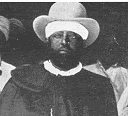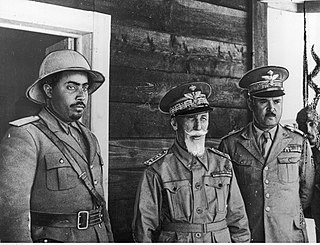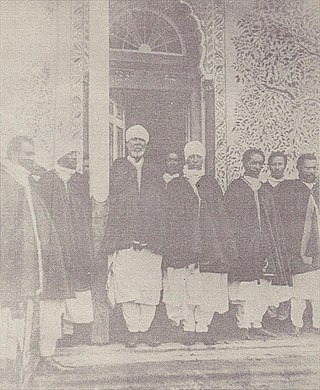Related Research Articles

RasDesta Damtew KBE was an Ethiopian noble, an army commander, and a son-in-law of Emperor Haile Selassie I. He is known for his leadership in the Ethiopian Army during the Second Italo-Ethiopian War. He was executed on 24 February 1937, by the Italian Armed Forces shortly after Ethiopia's loss in the war.

Ethiopian forces in the Second Italo-Abyssinian War besides the Central Army were mobilized from various provinces under their local leader. According to 1935 Italian intelligence estimates of the Ethiopian provinces and their forces on the eve of hostilities, the Ethiopians had an army of 350,000 men. Strengths where known are noted followed by their leader. Modernized forces in Bold.

RasKassa Hailu KS, GCVO, GBE, was a Shewan Amhara nobleman, the son of Dejazmach Haile Wolde Kiros of Lasta, the ruling heir of Lasta's throne and younger brother of Emperor Tekle Giyorgis II, and Tisseme Darge, the daughter of Ras Darge Sahle Selassie, brother of Menelik II's father.

DejazmachBalcha Safo, popularly referred to by his horse-name Abba Nefso, was an Ethiopian military commander and lord protector of the crown, who served in both the First and Second Italo-Ethiopian Wars.

Gugsa Welle, also known as Gugsa Wale, Gugsa Wolie and Gugsa Wele, was an army commander and a member of the imperial family of the Ethiopian Empire. He represented a provincial ruling elite which was often at odds with the Ethiopian central government.

The Battle of Shire was fought on the northern front of what was known as the Second Italo-Abyssinian War. This battle consisted of attacks and counterattacks by Italian forces under Marshal of Italy Pietro Badoglio and Ethiopian forces under Ras Imru Haile Selassie. This battle was primarily fought in the Shire area of Ethiopia.
De Bono's invasion of Ethiopia took place during the opening stages of the Second Italo-Ethiopian War. Italian General Emilio De Bono invaded northern Ethiopia from staging areas in the Italian colony of Eritrea on what was known as the "northern front".

The Christmas Offensive took place during the Second Italo-Ethiopian War. The Ethiopian offensive was more of a counteroffensive to an ever-slowing Italian offensive which started the war.

Seyoum Mengesha KBE was an army commander and a member of the royal family of the Ethiopian Empire.

Haile Selassie Gugsa CBE (1907–1985) was an Ethiopian army commander and member of the Imperial family from Tigray. He is known for betraying his country during the Second Italo-Ethiopian War and becoming a fascist collaborator.

Gugsa Araya Selassie was an army commander and a member of the royal family of the Ethiopian Empire.
The Battle of Anchem was fought between two factions of the Royal family in the Ethiopian Empire. The battle was fought to determine who would rule the empire, Empress Zewditu or King (Negus) Tafari Makonnen.
Wondosson Kassa, also known as Wond Wossen Kassa, was a member of the royalty of the Ethiopian Empire, an army commander, and a patriot.
Hailu Tekle Haymanot, also named Hailu II of Gojjam, was an army commander and a member of the nobility of the Ethiopian Empire. He represented a provincial ruling elite who were often at odds with the Ethiopian central government. Hailu Tekle Haymanot was an independent-minded potentate who, throughout his life, was mistrustful of and mistrusted by the Emperor.

RasAraya Selassie Yohannes was a son of Emperor Yohannes IV from his wife Masitire Selassie, a daughter of a Muslim Afar chieftain whom he married after she was Christened. Araya was nominated Crown Prince.
Gugsa Wale's rebellion of 1930 was a rebellion raised by Ras Gugsa Wale and by supporters of Empress Zewditu to rid her of the Crown Prince and heir apparent, Negus Tafari Makonnen. With Tafari gone, Zewditu would be the sole claimant to succession as the ruler of the Ethiopian Empire. As the husband of Empress Zewditu, Gugsa Wale expected to become Emperor.
Fikremariam was an Ethiopian commander and a patriot.
Adefrsew Yenadu (1873–1950) was an army commander, a member of the nobility of the Ethiopian Empire, and a patriot.

Wube Haile Maryam of Semien,, also called by his title Dejazmach Wube, Webé; his name is also given in European sources as ‘‘Ubie’’, was one of the major figures of 19th century Ethiopia, during the closing decades of the Zemene Mesafint a period of regional lords vying for power, prestige and territory amid a weakened authority of the emperors.
Gebre Tasfa better known as Gebre of Semien was the governor of Semien, Tsegede, Welkait and Wogera during the late 18th and early 19th century in Ethiopia. He held the title of Ras, and had an unusually long reign spanning 44 years during the tumultuous Zemene Mesafint when lords of each province and district continuously fought each other for supremacy. Ras Gebre was the primary backer of his son-in-law Emperor Tekle Giyorgis I claims to the throne.
References
- Barker, A.J. (1971). Rape of Ethiopia, 1936. New York: Ballantine Books. ISBN 978-0-345-02462-6.
- Fage, J.D.; Roberts, A.D.; Oliver, Roland Anthony (1994). The Cambridge History of Africa: From 1905 to 1940, Volume 7. Cambridge: Press Syndicate of the University of Cambridge. ISBN 0-521-22505-1.
- Haile Selassie I, Translated and Annotated by Edward Ullendorff (1999). My Life and Ethiopia's Progress: The Autobiography of Emperor Haile Selassie I, King of Kings and Lord of Lords, Volume I: 1892-1937. Chicago: Research Associates School Times Publications. p. 338. ISBN 0-948390-40-9.
- Haile Selassie I, Edited by Harold Marcus with others and Translated by Ezekiel Gebions with others (1999). My Life and Ethiopia's Progress: The Autobiography of Emperor Haile Selassie I, King of Kings and Lord of Lords, Volume II. Chicago: Research Associates School Times Publications. p. 190. ISBN 0-948390-40-9.
{{cite book}}:|first=has generic name (help) - Marcus, Harold G. (1994). A History of Ethiopia. London: University of California Press. p. 316. ISBN 0-520-22479-5.
- Mockler, Anthony (2002). Haile Sellassie's War. New York: Olive Branch Press. ISBN 978-1-56656-473-1.
- Pankhurst, Richard (2001). The Ethiopians: A History (Peoples of Africa). Wiley-Blackwell; New Ed edition. ISBN 0-631-22493-9.